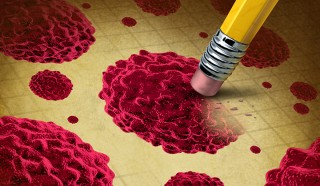Tiny Hair Follicle Holds Big Clues About the Life and Death of Stem Cells

Shutterstock
Stem cells are undifferentiated cells that replenish themselves and based on their tissue location can become specialized cells such as blood or skin cells.
The hair follicle is an ideal site for exploring stem cell behavior because it has distinct and predictable oscillations in the number and behavior of stem cells, said the study’s lead author Kailin R. Mesa, a third-year doctoral student in the lab of Valentina Greco, associate professor of genetics, cell biology and dermatology.
Using live microscopic imaging to track stem cell behavior in the skin of living mice, researchers observed that the stem cell niche, or surrounding area, played a critical role in whether stem cells grow or die.
“Prior to this, it wasn’t clear whether stem cell regulation was intrinsic or extrinsic, and now we know it is external in that the niche instructs the stem cells,” Mesa said.
“In terms of cancer, we can next explore how we might perturb or change the niche in hopes of affecting the growth of cancer stem cells.”
Also, researchers were surprised to find that the stem cells within the pool fed on other dying stem cells. This reveals a mechanism for removing dead cells, a process previously observed in mammary glands but never in the skin.
This study was supported by the Yale Dermatology Spore, National Institutes of Health, American Cancer Society, and New York Stem Cell Foundation.
Citation: Nature
Contact Information
Vicky Agnew
Sr. Communications Officer
vicky.agnew@yale.edu
Phone: 203-785-7001
Mobile: 843-697-6208
Media Contact
More Information:
http://www.yale.eduAll latest news from the category: Life Sciences and Chemistry
Articles and reports from the Life Sciences and chemistry area deal with applied and basic research into modern biology, chemistry and human medicine.
Valuable information can be found on a range of life sciences fields including bacteriology, biochemistry, bionics, bioinformatics, biophysics, biotechnology, genetics, geobotany, human biology, marine biology, microbiology, molecular biology, cellular biology, zoology, bioinorganic chemistry, microchemistry and environmental chemistry.
Newest articles

Trotting robots reveal emergence of animal gait transitions
A four-legged robot trained with machine learning by EPFL researchers has learned to avoid falls by spontaneously switching between walking, trotting, and pronking – a milestone for roboticists as well…

Innovation promises to prevent power pole-top fires
Engineers in Australia have found a new way to make power-pole insulators resistant to fire and electrical sparking, promising to prevent dangerous pole-top fires and reduce blackouts. Pole-top fires pose…

Possible alternative to antibiotics produced by bacteria
Antibacterial substance from staphylococci discovered with new mechanism of action against natural competitors. Many bacteria produce substances to gain an advantage over competitors in their highly competitive natural environment. Researchers…





















